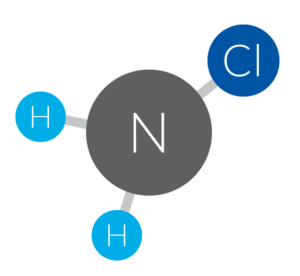Monochloramines: The Best Supplemental Disinfection for Legionella Control?
 Legionella, the bacteria responsible for Legionnaires’ disease, presents a significant challenge for water system managers. Testing and risk assessments sometimes show that some form of supplemental disinfection is necessary. Legionella and other waterborne pathogens thrive in various water environments, particularly in complex water systems such as those in hospitals, hotels, and large buildings. Effective control of Legionella is crucial to prevent outbreaks and protect public health. Among various disinfection methods, monochloramines have emerged as a leading choice for supplemental disinfection.
Legionella, the bacteria responsible for Legionnaires’ disease, presents a significant challenge for water system managers. Testing and risk assessments sometimes show that some form of supplemental disinfection is necessary. Legionella and other waterborne pathogens thrive in various water environments, particularly in complex water systems such as those in hospitals, hotels, and large buildings. Effective control of Legionella is crucial to prevent outbreaks and protect public health. Among various disinfection methods, monochloramines have emerged as a leading choice for supplemental disinfection.
Stability and Longevity
One of the primary benefits of monochloramines for Legionella control is its stability in water systems. Unlike free chlorine, which dissipates quickly, monochloramines provide a stable, long-lasting residual that ensures continuous disinfection throughout the entire water distribution network. This persistent presence makes monochloramines particularly effective in large and complex systems where maintaining consistent disinfectant levels can be challenging.
 Efficacy in Biofilm Penetration
Efficacy in Biofilm Penetration
Over 90% of Legionella reside within biofilms, which are protective layers formed by microorganisms on surfaces within water systems. Biofilms often shield Legionella from traditional disinfectants, making them difficult to eradicate. However, monochloramines have demonstrated superior efficacy in penetrating biofilms. Their ability to disrupt these protective layers enhances the overall disinfection process, ensuring that Legionella populations are effectively reduced.
Advantages in pH for Potable Water
Free chlorine is most effective in killing Legionella and other pathogens with a pH between 6-7.5. Most utilities keep the pH towards the top end of this range as they don’t want the water to be acidic and aggressive in picking up minerals from the distribution piping system. Monochloramines are effective up to a pH of 8.5, which is ideal for potable water systems.
Single Dosing at Point of Entry
Due to its stability, longevity, and lower oxidative nature, monochloramines are ideal for dosing at a single point of entry (POE) for supplemental disinfection. Chlorine, and to an even higher degree, chlorine dioxide need to be dosed in different locations in the piping systems. Generally, these chemicals are best to be dosed in hot and cold water systems separately and depending on the complexity of the piping system, many different dosing points could be necessary. If dosed at the POE, chlorine and chlorine dioxide will reduce too rapidly in the hot water to have an effective residual to combat Legionella. If dosed at a high enough level to be effective in hot water, the level of chemicals in the cold water piping is often too high.
Reduced Formation of Disinfection Byproducts
A significant concern with many disinfectants used for Legionella control is the formation of harmful disinfection byproducts (DBPs) when they react with organic matter in water. These byproducts can pose health risks and complicate water treatment efforts. Monochloramines, however, are less reactive with organic matter compared to chlorine due to their weaker oxidation strength. This reduced reactivity leads to fewer DBPs, making monochloramines a safer and more environmentally friendly option for long-term water system management.
Safety for Human Consumption
Safety is paramount when selecting a secondary disinfection method for drinking water systems. Monochloramines, when used at appropriate levels, are safe for human consumption and have been utilized in water treatment for decades. More and more municipalities in the United States are moving towards monochloramines as primary disinfection. The maximum dose rate for potable water is 4 ppm, like with other chlorine-based chemicals. Chlorine dioxide, however, has a maximum dosing rate of 0.8 ppm. Regulatory agencies, including the Environmental Protection Agency (EPA), recognize monochloramines as a safe disinfectant for drinking water. Their long history of safe use provides reassurance for both water system operators and the public.
Cost-Effectiveness
In addition to their technical advantages, monochloramines offer cost benefits when fighting Legionella. Their stability reduces the need for frequent reapplication, which can lower operational costs. Furthermore, the decreased formation of DBPs can result in lower expenses related to regulatory compliance and treatment processes required to mitigate these byproducts.
Conclusion
Monochloramines stand out as one of the best supplemental disinfection methods for controlling Legionella in water systems. Their stability, efficacy in penetrating biofilms, reduced formation of harmful byproducts, and safety for human consumption make them an ideal choice for ensuring safe and healthy water supplies. By incorporating monochloramines into water treatment protocols, facilities can significantly reduce the risk of Legionella contamination and the growth of biofilm.
For more information on reliable, effective, and safe disinfection methods, contact Legionella Control Systems at 888-416-8626 or info@legionellacontrolsystems.com to see if monochloramines are the right solution for you. Legionella Control Systems is an independent consulting firm and can speak with you about the best option for supplemental disinfection for your facility.








